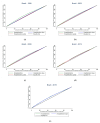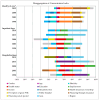Effects of Primary Healthcare Quality and Effectiveness on Hospitalization Indicators in Brazil
- PMID: 40416334
- PMCID: PMC12101434
- DOI: 10.3390/jmahp13020021
Effects of Primary Healthcare Quality and Effectiveness on Hospitalization Indicators in Brazil
Abstract
Advances in primary healthcare coverage for the improvement in health outcomes at the population level comprise a major goal of public policies of health, particularly considering increases in hospitalization costs linked to chronic diseases in recent decades. Previous evidence shows the positive effects of access to primary healthcare on hospitalization indicators in high-income countries; however, there is a lack of literature on the subject in Latin American countries. Thus, the present study proposes a quantitative investigation on connections between primary healthcare quality and effectiveness in relation to hospitalization indicators, in addition to the identification of its effects on inequalities in hospitalizations in Brazil. The study was based on an empirical analysis of data from five cross-sectional surveys representative at the population level conducted by the Brazilian Institute for Geography and Statistics (IBGE) in 1998, 2003, 2008, 2013, and 2019. Information on the demographic, socioeconomic, and health characteristics of individuals compatible across surveys were included in the analyses, in addition to data on household and survey characteristics. The statistical analyses were based on the estimation of logistic regression models for the exploration of effects of primary healthcare quality and effectiveness on hospitalizations, inpatient days, and perception of quality of hospital care. Furthermore, the estimation of concentration indexes and their disaggregation allowed to verify trends and determinants of inequalities in hospitalization indicators in Brazil throughout the period. The results indicate that primary healthcare effectiveness is associated with the lower occurrence and frequency of hospitalizations, and a lower length of stay in hospitals. Primary healthcare quality was associated with the perception of higher quality of hospital care. Trends in hospitalization indicators showed reduction in inequalities towards low-income individuals from 1998 to 2013, and primary healthcare quality presented minor influence on inequalities in hospitalizations, inpatient days, and perception of quality of hospital care.
Keywords: health system; healthcare effectiveness; healthcare management; healthcare quality; patient satisfaction.
© 2025 by the authors.
Conflict of interest statement
Conflicts of InterestThe authors declare no conflicts of interest. The funders had no role in the design of the study; in the collection, analyses, or interpretation of data; in the writing of the manuscript; or in the decision to publish the results.
Figures


Similar articles
-
Determinants of Patients' Perception of Primary Healthcare Quality: Empirical Analysis in the Brazilian Health System.Healthcare (Basel). 2025 Apr 9;13(8):857. doi: 10.3390/healthcare13080857. Healthcare (Basel). 2025. PMID: 40281806 Free PMC article.
-
COVID-19 inpatient mortality in Brazil from 2020 to 2022: a cross-sectional overview study based on secondary data.Int J Equity Health. 2023 Nov 17;22(1):238. doi: 10.1186/s12939-023-02037-8. Int J Equity Health. 2023. PMID: 37978531 Free PMC article.
-
Decomposing the inequalities in the catastrophic health expenditures on the hospitalization in India: empirical evidence from national sample survey data.Front Public Health. 2024 Apr 4;12:1329447. doi: 10.3389/fpubh.2024.1329447. eCollection 2024. Front Public Health. 2024. PMID: 38638464 Free PMC article.
-
The 2023 Latin America report of the Lancet Countdown on health and climate change: the imperative for health-centred climate-resilient development.Lancet Reg Health Am. 2024 Apr 23;33:100746. doi: 10.1016/j.lana.2024.100746. eCollection 2024 May. Lancet Reg Health Am. 2024. PMID: 38800647 Free PMC article. Review.
-
Evidence Brief: Effectiveness of Intensive Primary Care Programs [Internet].Washington (DC): Department of Veterans Affairs (US); 2013 Feb. Washington (DC): Department of Veterans Affairs (US); 2013 Feb. PMID: 27606397 Free Books & Documents. Review.
References
-
- Cavagnero E., Almeida G., Seely E.S., Marinho F. Setting the context for universal health coverage reforms in Latin America and the Caribbean. In: Dmytraczenko T., Almeida G., editors. Toward Universal Health Coverage and Equity in Latin America and the Caribbean: Evidence from Selected Countries. World Bank; Washington, DC, USA: 2015. pp. 19–51.
-
- Trindade L.A.I., Pereira J.L., Leite J.M.R.S., Rogero M.M., Fisberg R.M., Sarti F.M. Lifestyle and cardiometabolic risk factors associated with impoverishment due to out-of-pocket health expenditure in São Paulo City, Brazil. Int. J. Environ. Res. Public Health. 2024;21:1250. doi: 10.3390/ijerph21091250. - DOI - PMC - PubMed
-
- Baldwin W. What’s changing the world? A demographer’s perspective. In: Singelmann J., Poston D. Jr., editors. Developments in Demography in the 21st Century. Springer; Cham, Switzerland: 2020. - DOI
LinkOut - more resources
Full Text Sources
